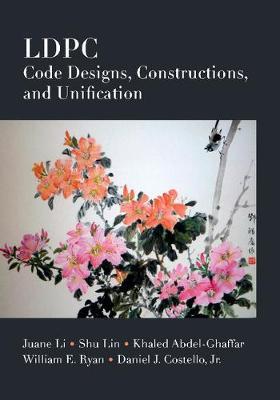Overview
Written by leading experts, this self-contained text provides systematic coverage of LDPC codes and their construction techniques, unifying both algebraic- and graph-based approaches into a single theoretical framework (the superposition construction). An algebraic method for constructing protograph LDPC codes is described, and entirely new codes and techniques are presented. These include a new class of LDPC codes with doubly quasi-cyclic structure, as well as algebraic methods for constructing spatially and globally coupled LDPC codes. Authoritative, yet written using accessible language, this text is essential reading for electrical engineers, computer scientists and mathematicians working in communications and information theory.
Full Product Details
Author: Juane Li (University of California, Davis) ,
Shu Lin (University of California, Davis) ,
Khaled Abdel-Ghaffar (University of California, Davis) ,
William E. Ryan
Publisher: Cambridge University Press
Imprint: Cambridge University Press
Dimensions:
Width: 18.00cm
, Height: 1.60cm
, Length: 25.30cm
Weight: 0.660kg
ISBN: 9781107175686
ISBN 10: 1107175682
Pages: 259
Publication Date: 01 December 2016
Audience:
Professional and scholarly
,
Professional & Vocational
Format: Hardback
Publisher's Status: Active
Availability: Available To Order

We have confirmation that this item is in stock with the supplier. It will be ordered in for you and dispatched immediately.
Reviews
Advance praise 'This book provides an in-depth survey of recently developed quasi-cyclic LDPC codes. It is a treasured reference on practical channel coding methods for both theorists and practitioners working in communications and information theory.' Lara Dolecek, University of California, Los Angeles Advance praise: 'The importance of LDPC codes in numerous applications and their capacity-approaching performance has led to an explosion in research into their construction and analysis over the past decade. The numerous effective constructions of them can be broadly classified as algebraic and graphical, including the important superposition, protograph and spatial coupling techniques. This timely volume explains, unifies and greatly clarifies these diverse approaches and lays a solid foundation that will be invaluable to researchers, practitioners and students alike.' Ian F. Blake, University of British Columbia, Vancouver Advance praise: 'A book from the leaders in the field of error-correcting codes. Superposition - a unified framework for low-density parity check code construction - makes a description of codes of various classes rather simple.' Bane Vasic, University of Arizona, Tucson
'This book provides an in-depth survey of recently developed quasi-cyclic LDPC codes. It is a treasured reference on practical channel coding methods for both theorists and practitioners working in communications and information theory.' Lara Dolecek, University of California, Los Angeles 'The importance of LDPC codes in numerous applications and their capacity-approaching performance has led to an explosion in research into their construction and analysis over the past decade. The numerous effective constructions of them can be broadly classified as algebraic and graphical, including the important superposition, protograph and spatial coupling techniques. This timely volume explains, unifies and greatly clarifies these diverse approaches and lays a solid foundation that will be invaluable to researchers, practitioners and students alike.' Ian F. Blake, University of British Columbia, Vancouver 'A book from the leaders in the field of error-correcting codes. Superposition - a unified framework for low-density parity check code construction - makes a description of codes of various classes rather simple.' Bane Vasic, University of Arizona, Tucson
Author Information
Juane Li is a postdoctoral researcher in the Department of Electrical and Computer Engineering at the University of California, Davis. Her current research interests are channel coding for communications and storage systems, and hardware implementation of encoders and decoders for LDPC codes. Shu Lin is an Adjunct Professor in the Department of Electrical and Computer Engineering at the University of California, Davis, and an IEEE Life Fellow. He is the co-author of Channel Codes: Classical and Modern (Cambridge, 2009) and Error Control Coding: Fundamentals and Applications (2nd edition, 2004). Khaled Abdel-Ghaffar is Professor of Electrical and Computer Engineering at the University of California, Davis. He has held research positions at the IBM Almaden Research Center, Delft University of Technology, and the University of Bergen. William E. Ryan is an IEEE Fellow and currently works for Zeta Associates, USA. He was previously a professor at New Mexico State University and the University of Arizona. He is the co-author of Channel Codes: Classical and Modern (Cambridge, 2009). Daniel J. Costello, Jr, is the Leonard Bettex Professor Emeritus of Electrical Engineering at the University of Notre Dame, and an IEEE Fellow. He is the co-author of the textbook Error Control Coding: Fundamentals and Applications (2nd edition, 2004).




